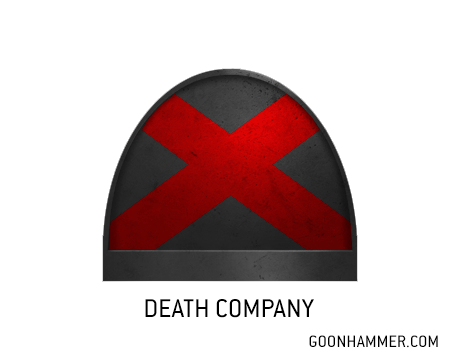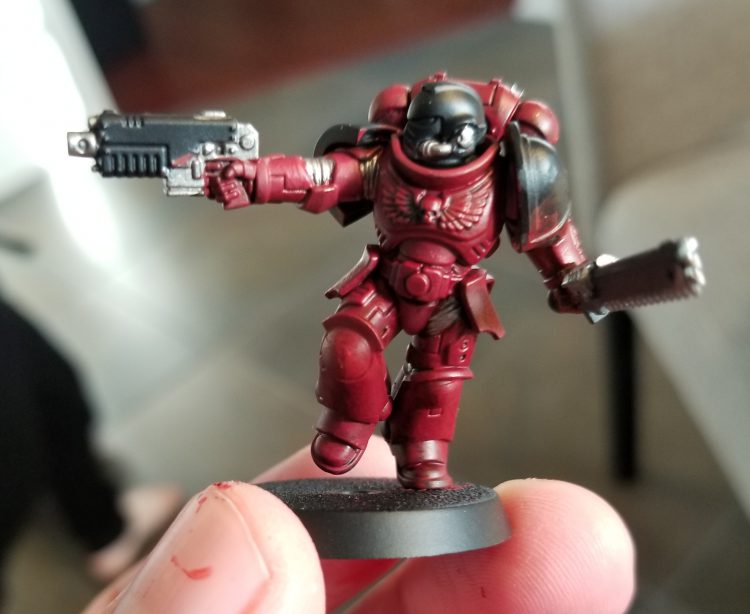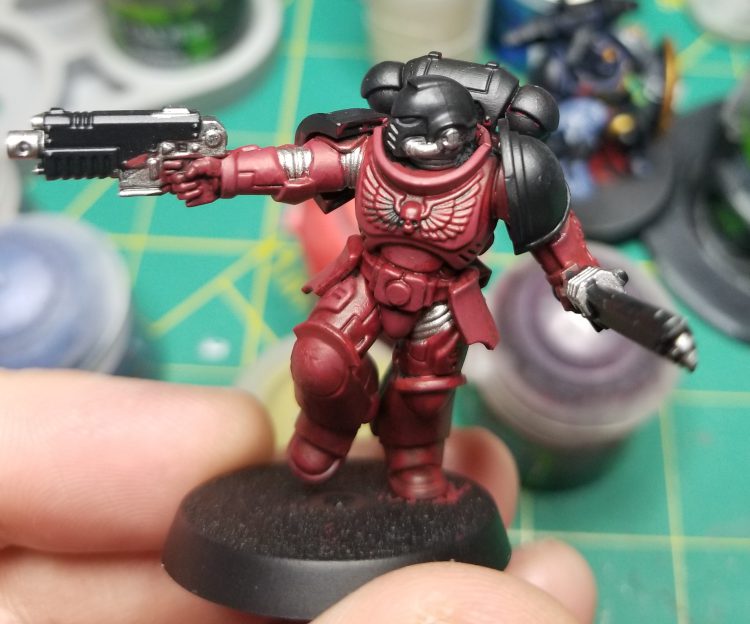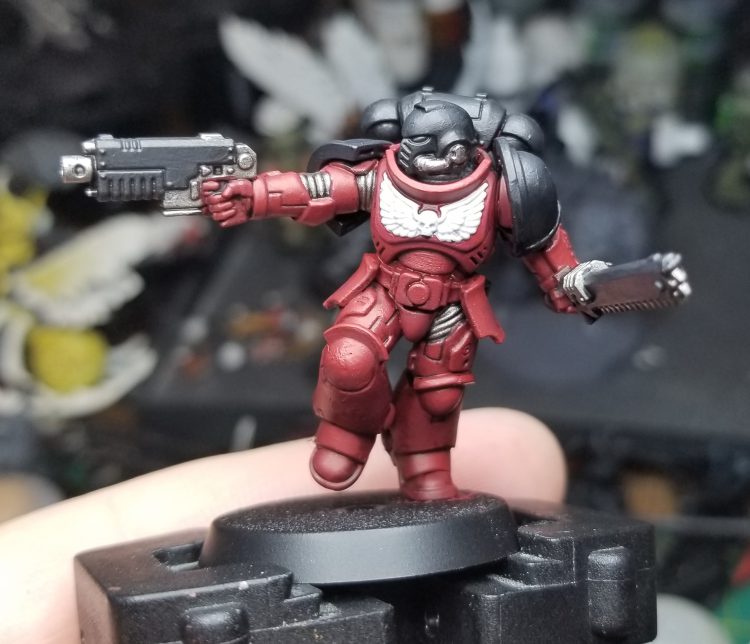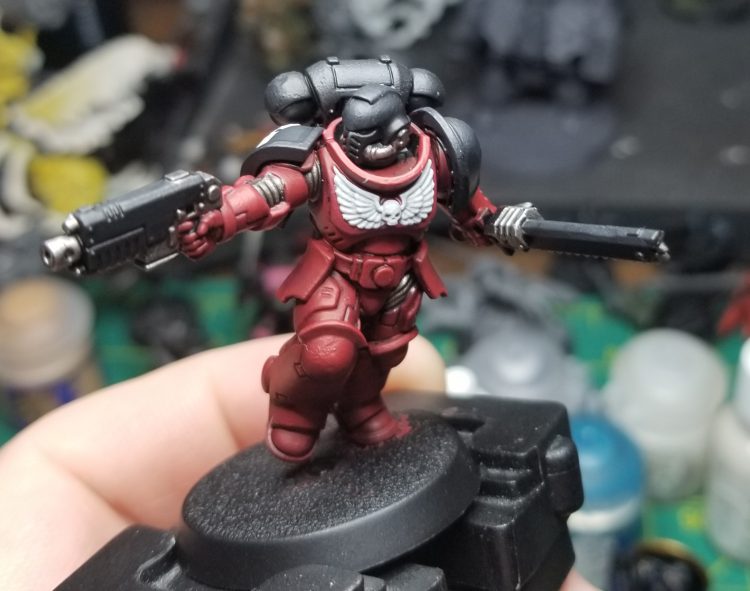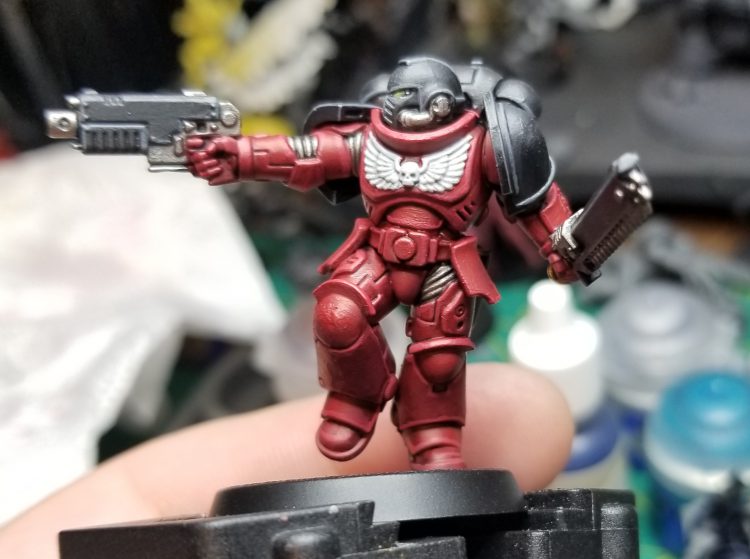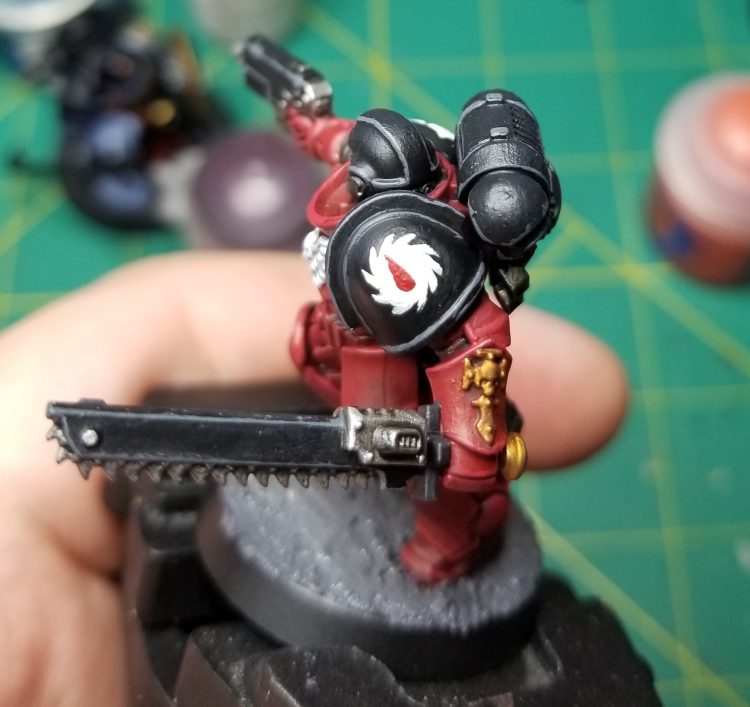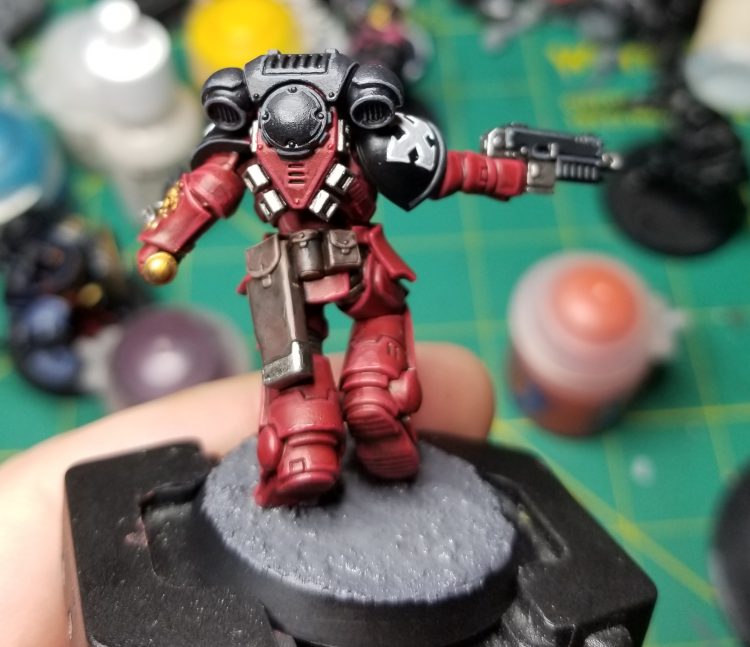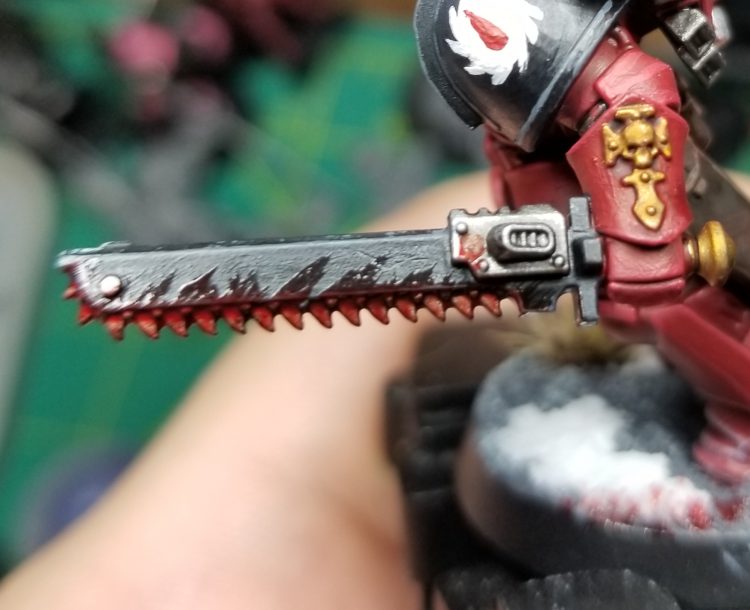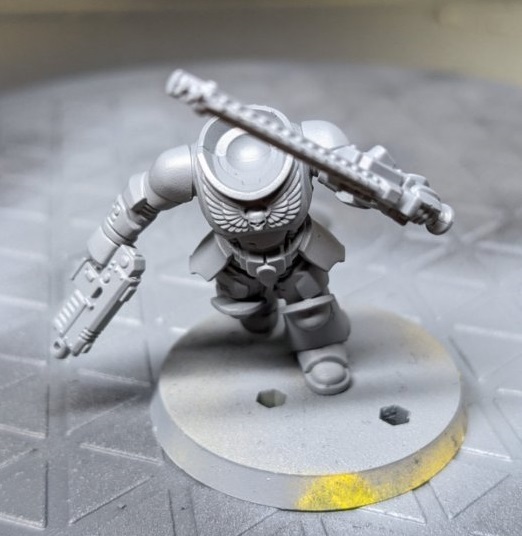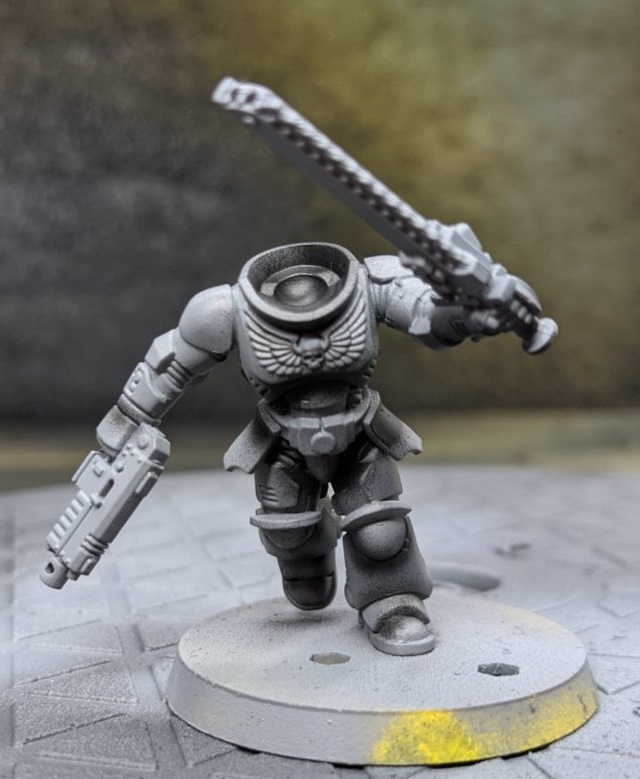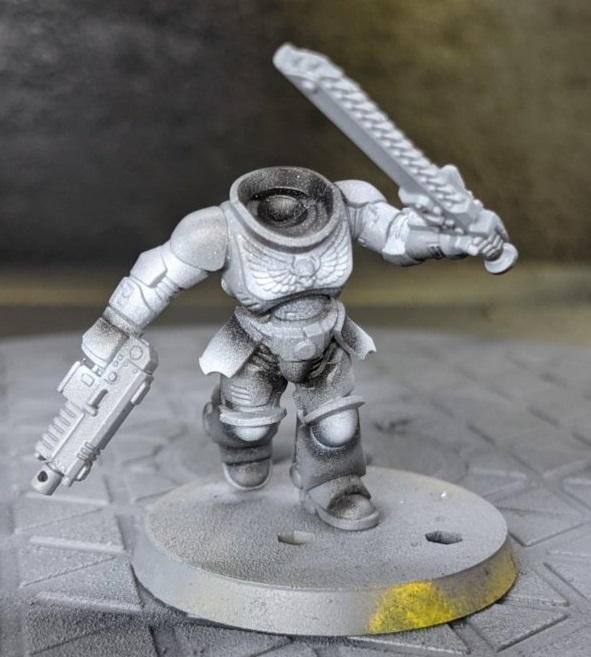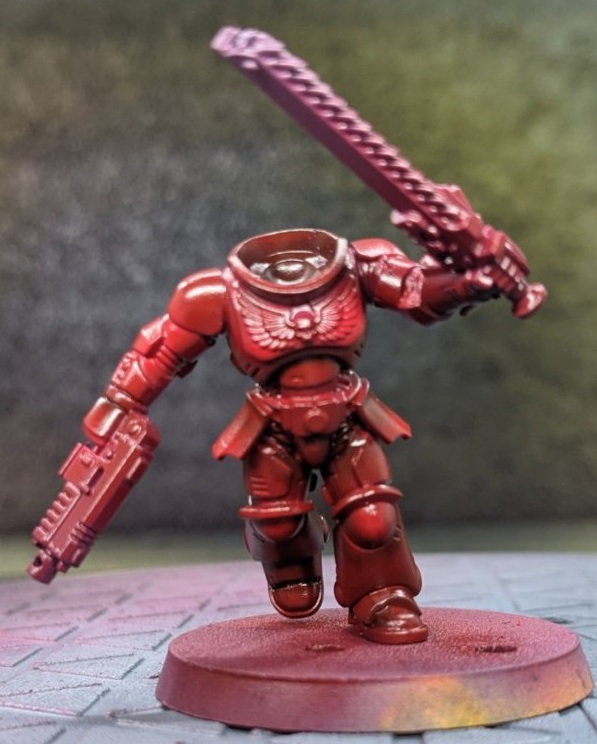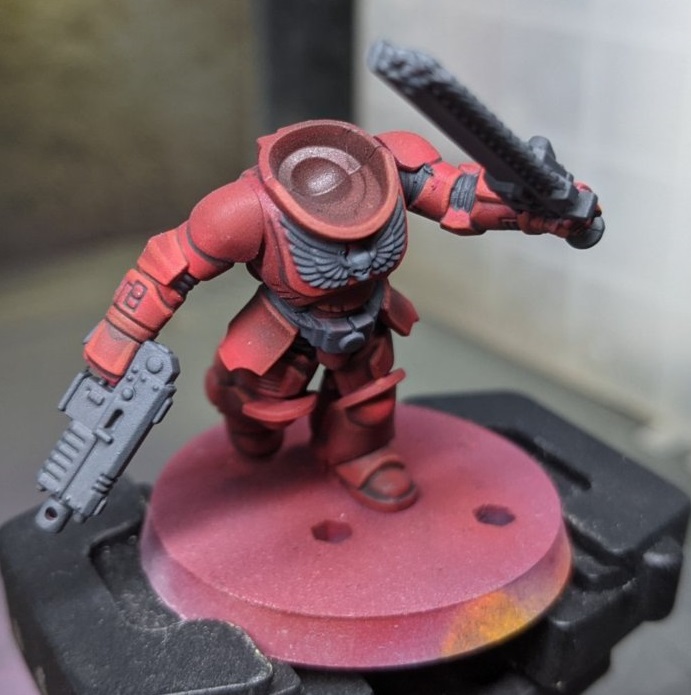This article is part of a larger series on how to paint Space Marines. To return to that series, click here.
The Flesh Tearers are a Blood Angels successor Chapter, famous – or infamous – throughout the galaxy for their savagery in battle. All of the Sons of Sanguinius bear the twin curses of the Flaw – the Red Thirst and the Black Rage – but the Flesh Tearers are even more susceptible to these than others. Their Marines fall to the Black Rage at a terrifying rate, swelling their Death Company but weakening the rest of the Chapter. This degradation has worsened over time, and many in the Flesh Tearers have embraced it, furthering the slip into madness.
Flesh Tearers are a bit easier than your usual chapter with split armor in that their differently-colored elements are shoulder pads, backpacks, and helmets, all elements that are relatively easy to paint separately from the main model. This frees you up to be a lot less careful when applying base coats and highlighting to the red parts of your model.
Covered in this Article
- How to paint the Flesh Tearers, with five different methods of tackling the Chapter warriors.
- A guide to Flesh Tearers Heraldry and how to visually distinguish different companies and squads within the Chapter.
Heraldry - Click to Expand
While the Flesh Tearers aren’t a Codex-Compliant chapter – they follow the organizational structure of the Blood Angels – they broadly follow the Codex Astartes in a number of ways, including the organization of the Chapter and color markings for companies. However, rather than varying the color of shoulder pad trim, Flesh Tearers feature a single droplet on their right shoulder overlapping their squad designation, the color of which denotes their company. Unlike the blood angels, they mostly use the standard Codex Astartes colors for their companies.
Flesh Tearers use white gothic script on their right kneepad to denote their squad number within a company. Death Company are marked in a similar fashion to Blood Angels, with black armor bearing a red X across the right shoulder.
Drybrush Threepwood's Method - Click to expand
Hi there readers. The staff at Goonhammer were kind enough to reach out and ask me to put together a guide on how I do my Flesh Tearers. I owe a great debt to their painting guides as I was inspired by their How To Paint Iron Hands article a while ago to make significant changes to my own process, and I was beyond chuffed that they’d given me the opportunity to contribute some of my tips in turn.

First, a note on assembly. I like to keep my helmets and backpacks attached with blutac at first so I can get the initial shades done with the whole model then work in subassembly, but you can get away with just keeping the head separate if it proves too fiddly.
Step 1. Priming and Undercoating
Prime with Stynlrez Black. You can add an optional layer of VMA Black so the surface isn’t as matte if you prefer.
Next preshade black armour with Tamiya XF-2 Flat White, thinned 4:1 with their X-20A Thinner. You could use any white here, but I strongly recommend giving Tamiya a try. It has a much lower tendency to speckle or spider compared to other solutions like inks or white primer, you can build from a grey up to pure white, and it clogs less in the airbrush.
When shading, pick a light source you want to use and stick with it across the model. You want to leave pure black on the surface and just add a highlight where the light will hit it the most.
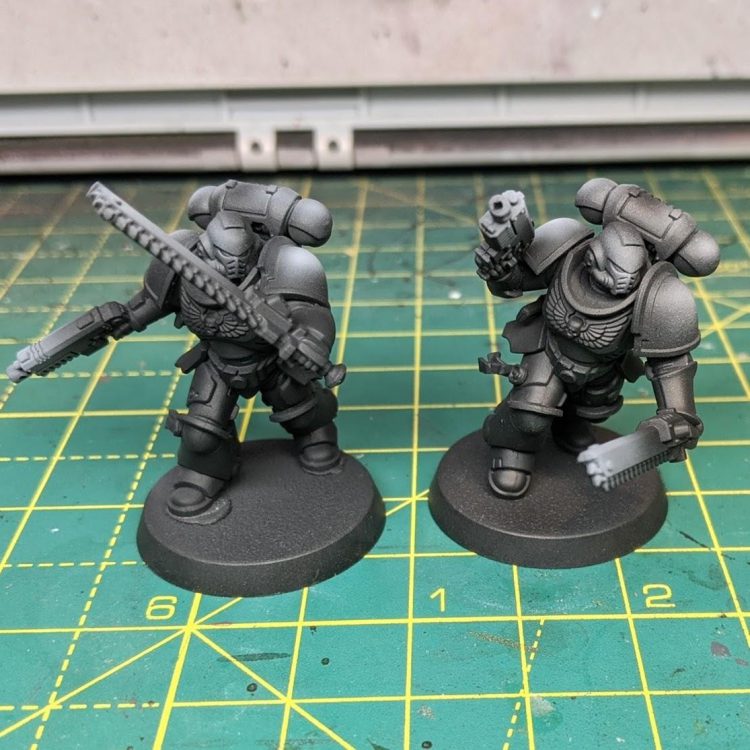
Shade with Black Templar Contrast. We’re using the BT contrast as a tint here to bring the pure white back down, and use the greenish hue of the paint to add some visual interest to the model. Spray from the centre of your highlight out so you keep a smooth transition to black.
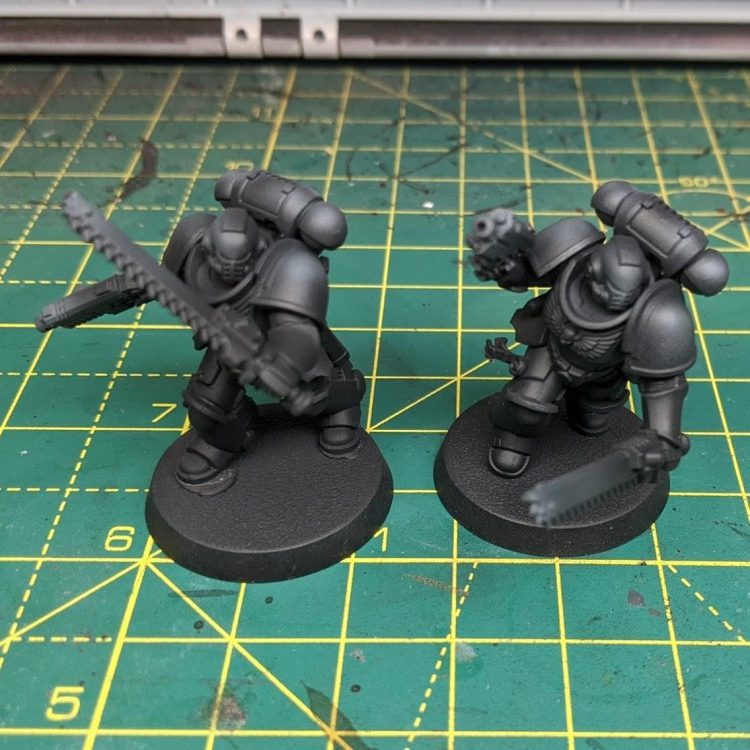
Remove your heads and backpacks, stick them to something so you can paint them in subassembly, and mask off the black armour with Masking Putty.
Step 2. The Red Armour
Preshade the red armour with flat white. The approach here is slightly different as we want to make sure only the deepest recesses are left pure black. As contrast paint is transparent if there isn’t anything underneath for it to tint it won’t show much colour. If you like deeper black to red transitions you can be more sparing here, I prefer my red armour to be on the more vibrant side.
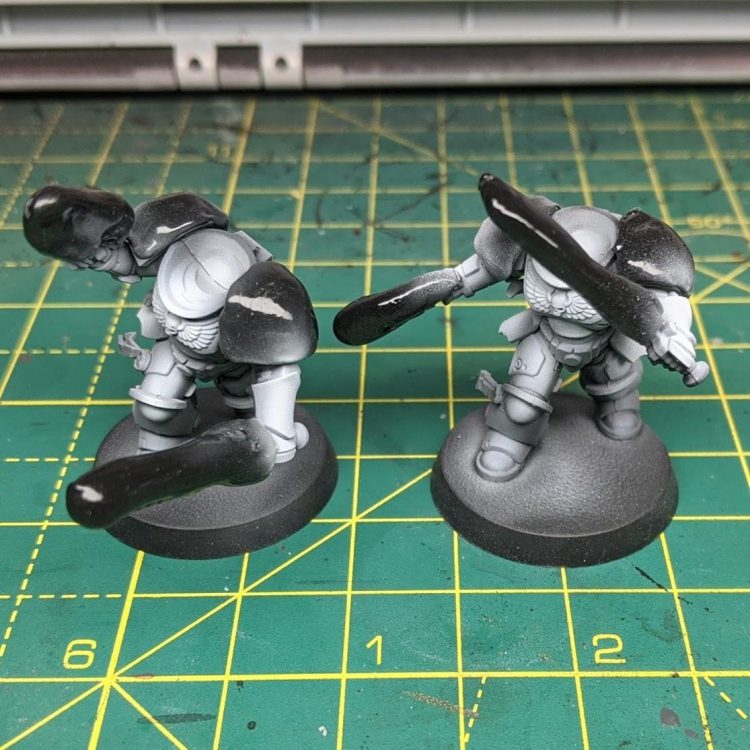
Shade red armour Flesh Tearer Contrast thinned 3:1. Here we want to shade from the recesses towards the brightest spots so we keep the saturation at its highest where light hits the model. You’ll need to give it 3 or so passes, just keep going if it looks pink and remember to pause to let the model dry if you’re unsure if it needs another layer.
If you want to see this process in more detail I’d recommend watching Cult of Paint’s excellent tutorial on preshading via their YouTube channel.
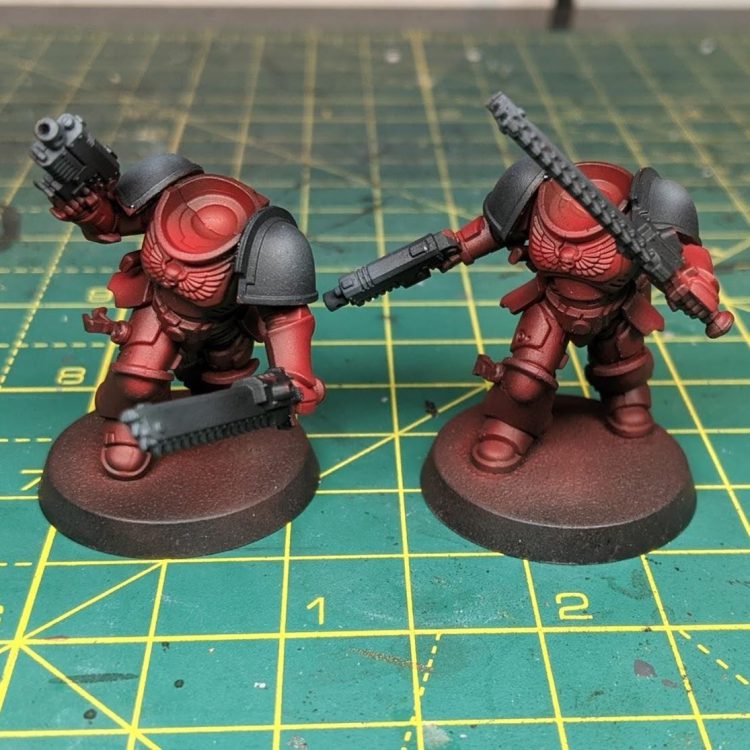
Base coats
-
- Undersuit & Crest: VMC Black Grey
- Metals: Scale 75 Black Metal
- Leather: VMC German Camo Black Brown
- Wax: Screamer Pink
- Parchment: VMC Iraqi Sand
Apply an all over coat of Vallejo Mecha Gloss Varnish and let it dry for 24 hours.
Transfers
Transfers – I’ll keep this brief as plenty has been written here already; I get all my sets from Mighty Brush and do the following:
-
- Apply with Micro Set, dab with a cotton bud, dry for 12 hours
- Apply Micro Sol, dry for 12 hours
Washes
Wash with Army Painter Quickshade Dark Tone. Mix your Dark Tone with their Quickshade Wash Mixing Medium and some Warcolours Surfactant with equal parts surfactant to your dark tone + medium mix. I use 3 parts Dark Tone to 2 parts medium, you can go darker or brighter by adjusting this ratio
The surfactant is what makes this really magic; with this in the mix your wash will slide right off the model and only stay in the recesses. Slather your mix over the whole mini. Keep an eye on it for about 5 minutes and if you do see pools like this one on the leg plate building up wick them away with a clean brush. Next, wash the joints and crest with pure dark tone to push them further.
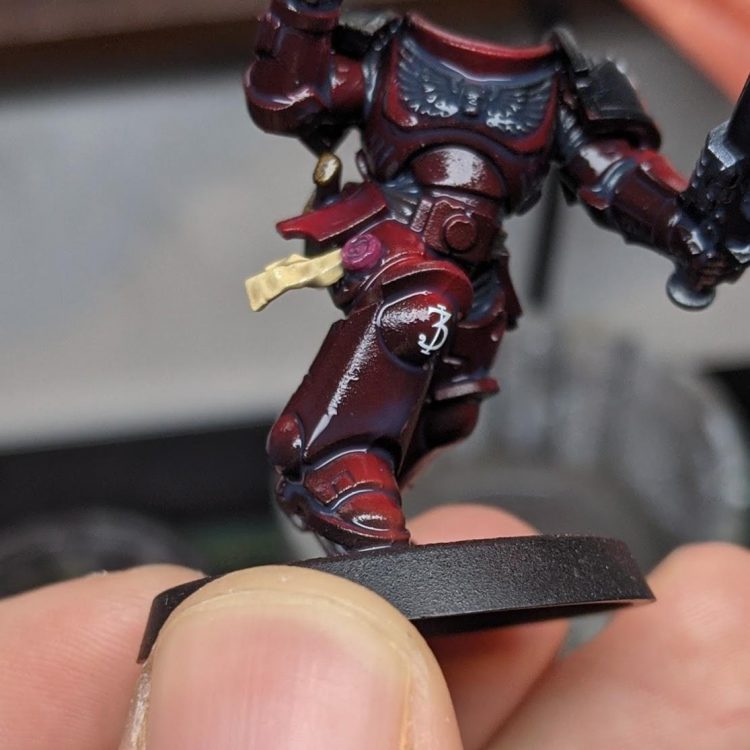
Once your wash is dry (I give it 24 hours) apply an Ultra Matte Varnish. While you’re there shade the lower half of your transfers with thinned (3:1) Liquitex Black Ink to blend them into the model.
Edge Highlights
Edge highlights
-
-
- Undersuit: VMC Dark Grey, VMC Dark Blue Grey
- Black Armour & Crest: VMC Dark Blue Grey, VMC Neutral Grey
- Red Armour: Wazdakka Red, Squig Orange
- Leather: VMC Burnt Umber
- Parchment: VMC Pale Sand
- Wax: Genestealer Purple
-
We’re not aiming to hit every edge here as we’ve already got highlighting from our airbrush gradients, instead try to aim for only edges that would catch the light with your first stage highlight and only the most dramatic edges with your second stage.
Reattach the heads and backpacks with some super glue
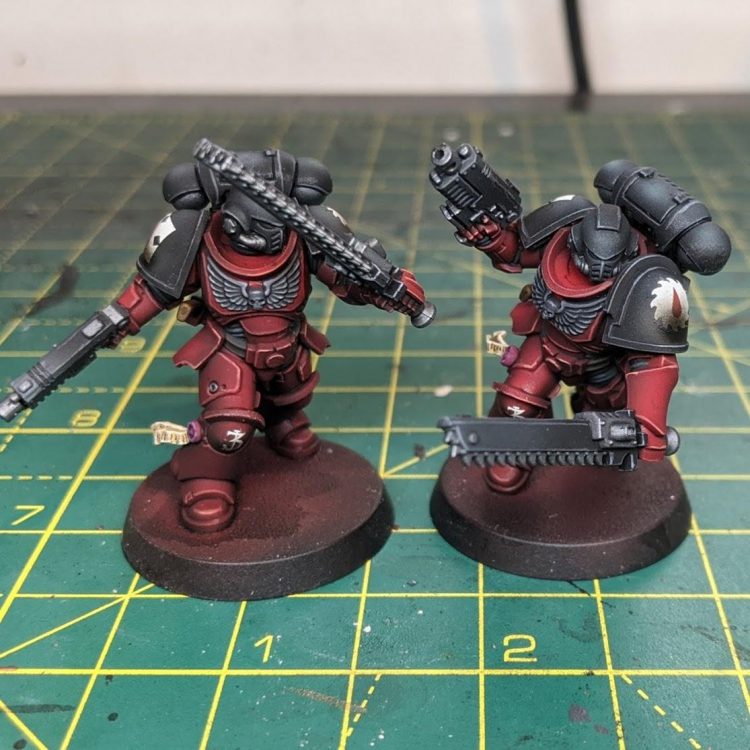
Weathering and Chipping
Dab a bit of sponge in black paint, drush it off on some paper towel until it’s just leaving speckles, and apply some speckling to the transfers. Draw some black lines and chips the armour with black, then edge highlight them with your second stage highlight. I apply text to the parchment at this stage with a Sepia Micron Pen.
Basing
Use cork sheets to build up depth, cover it with Vallejo Earth Texture, add rocks for variety and let it dry for 24 hours. Prime the whole surface, base it with Zandri Dust, wash with Seraphim Sepia, then drybrush with VMC Buff and Pale Sand. Rod your mini to the base. Don’t try and get away with just super gluing them, you will rip the base apart the first time your mini snags on something. Yes I know this from experience
Apply some sand pigment to the lower legs and the base, I use North Africa Dust.
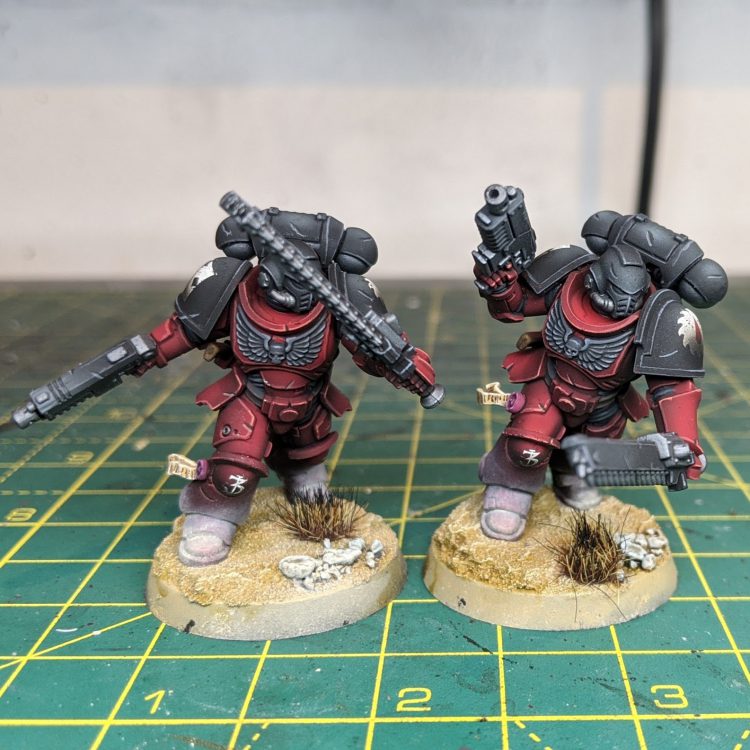
Apply another layer of Ultra Matte Varnish to bind the pigment and give the whole model a consistent finish.
Now it’s time to fix our metallics to get their sheen back up and paint the details on any reflective surfaces like lenses and gems. Reapply Black Metal leaving your shade in just the recesses, and edge highlight with S75 Heavy Metal.
I’m not going to write how I do my lenses as I’m using a method from Mighty Brush’s how to paint Blood Angels guide. These are wonderfully laid out tomes that go into detail on many of the techniques I’ve used here and I can’t recommend them strongly enough. You can also use Goonhammer’s tutorials from How to Paint Space Marines, or How to Paint Lenses, gemstones, and vials.
Blood spatter
The fun part! Get a brush, load it with some Blood for the Blood God and get your airbrush out.
With some kitchen towel laid out, give your brush some test blasts with your airbrush. Vary the distance between the brush and the towel and your airbrush and the brush until you find a level of spatter that works for you. You don’t want to head straight into doing this on your model or you risk wiping out a lot of your work.
Once you start spraying your dudes keep a clean brush on hand and if any splatter gets somewhere you don’t want, it like in an eye lense, as long as you’re quick you can wipe it away with a bit of water.
Laugh maniacally as you imagine your Flesh Tearers making the nearest thing they can find (Heretics, xenos, allies, they’re not picky) extraordinarily dead. This step is not optional.
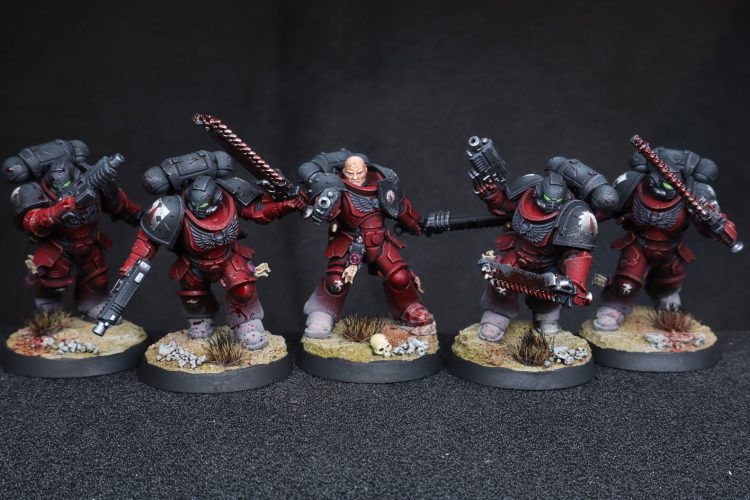
TheChirurgeon's Method - Click to Expand
I’ve always been a fan of the Flesh Tearers since I first saw them in their Index Astartes article of an old White Dwarf. They have a striking color scheme and a very cool backstory. They’re basically the cooler, Khorne-ier version of Blood Angels.
Step 1. Basecoats
The process started with an undercoat of black primer followed by a couple of thin coats of Khorne Red on the armor and some Leadbelcher on the metal parts.
Step 2: More Basecoats and Shading
Then I laid down the black on the shoulder pads and helmet with Abaddon Black. Also this is the step where I realized I wanted to make the top of the backpack black. I’ve also started shading the red with some Carroburg Crimson.
Step 3. More Shading
Here’s where the more complex shading starts. I’ve traced the armor grooves with Carroburg Crimson and a bit of Nuln Oil in the darkest recesses, painted the Aquila and the Assault company marking with Grey Seer, washed the metal parts with Nuln Oil, and started shading the black parts. This is done by mixing Abaddon Black and Corvus Black and working up to Corvus Black on the raised parts of the black armor. You can also shade Corvus Black with Nuln Oil for extra depth.
Step 4. Highlights
I’m also highlighting the reds at this stage, doing blends of Khorne Red with Mephiston Red. The White parts get washed with Apothecary White, which we’ll then revisit, shading in the spots in-between feathers with Nuln Oil and doing some extra highlights with Reaper Pure White.
At this stage I’m doing more red highlight as well, doing edge highlights on the red with Wazdakka Red. I also cover the eyes, doing them in a gemstone style using Warpstone Glow shaded with Coelia Greenshade and Nuln Oil and highlight with a spot of Moot Green.
Step 5. Heraldry
Next up is freehanding the saw blade icon on the left shoulder pad. I start with a circle and then paint the teeth off of that, then come back and add the blood tear with Mephiston Red.
Step 6. Edge Highlights
The black parts get an edge highlight of Mechanicus Standard Grey at this point and the gold parts are just Retributor Armour washed with Agrax Earthshade. The leather is Rhinox Hide washed with Agrax Earthshade then edge highlighted with Gorthor Brown.
Step 7. Final Details
Now for the finishing touches. A Flesh Tearer should be blood-stained so I drop some Blood for the Blood God on his chainsword and some drops on the base to make him suitably stained. The base is Astrogranite drybrushed with Celestra Grey and then some Valhallan Blizzard and tufts of Army Painter static grass on top of that. I’m very happy with how this guy turned out and may paint more of these in the future if I can settle on a faster way to do the shoulder pad icons.
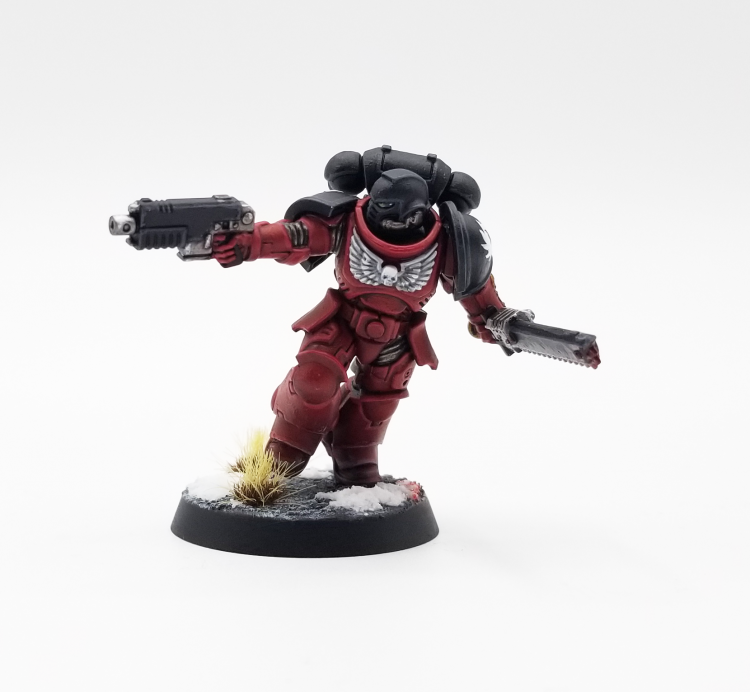

Skails' Method - Click to Expand
Paints used:
Armor:
Vallejo Model Color German Grey
Vallejo Game Color Stonewall Grey
Pro Acryl Coal Black
Citadel Khorne Red
Citadel Wild Ryder Red
Vallejo Bloody Red
Scale75 Hyek Yellow
Pro Acryl Burnt Orange
Citadel Druchii Violet Shade
Bolter/Metal Bits:
Citadel Leadbelcher
Citadel Nuln Oil
Shells/Aquila:
Scale 75 Antique Brass
Citadel Reikland Fleshshade
Lenses:
Vallejo Goblin Green
Pro Acryl Yellow Green
The Process
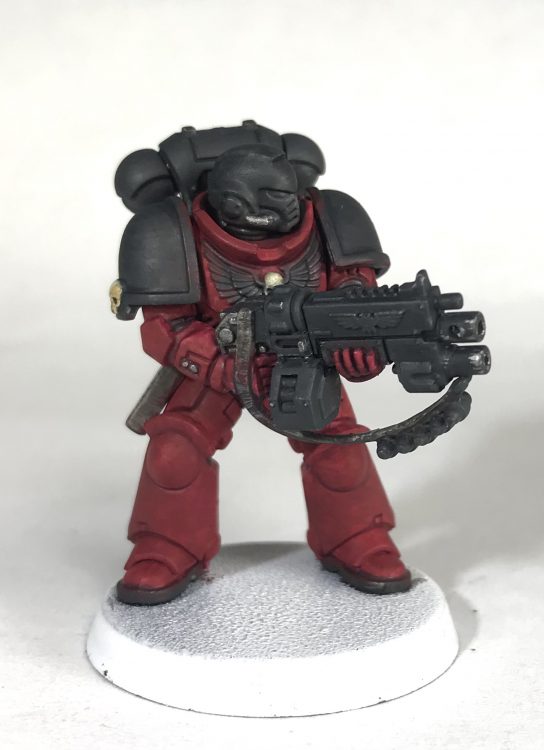
Basecoats: Vallejo German Grey for all the black parts of the armor. Citadel Khorne Red for all the red parts.

Panel lines and recess shading
Panel lines and deep recesses: Nuln Oil on Black parts. Druchii Violet on red armor. Nuln oil in deepest recesses of red armor. This picture has some loose highlights of a mid-tone grey on the black armor and Bloody Red on red armor, and a bit of Wylde Rider Red on highest points.
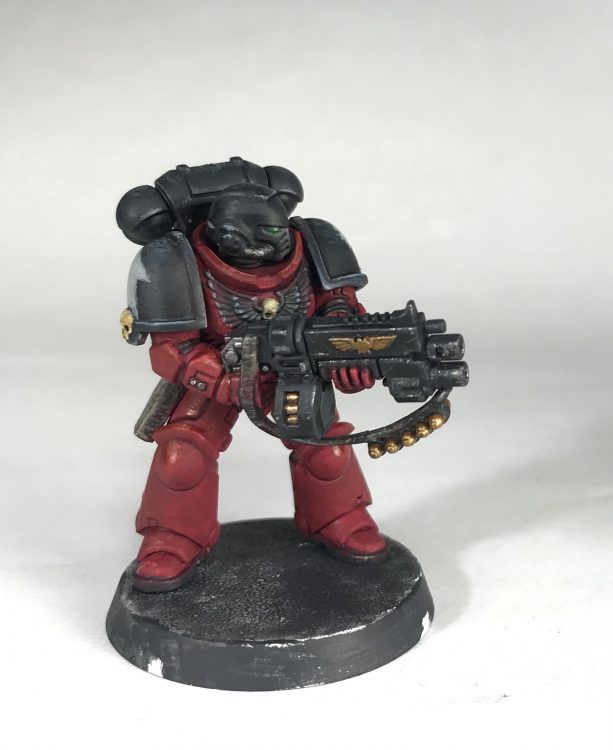
Black Armor: Shaded with Coal Black. Some more highlight built up with a Coal Black and Stonewall Grey mix. Some edges on the rifle are stippled with Leadbelcher and some scratches added to simulate wear.

Red Armor Shading: Nuln Oil stippled and splotched loosely over lower areas, along recesses, undersides of armor. A second coat of Nuln Oil for a few darker splotches in shade area.
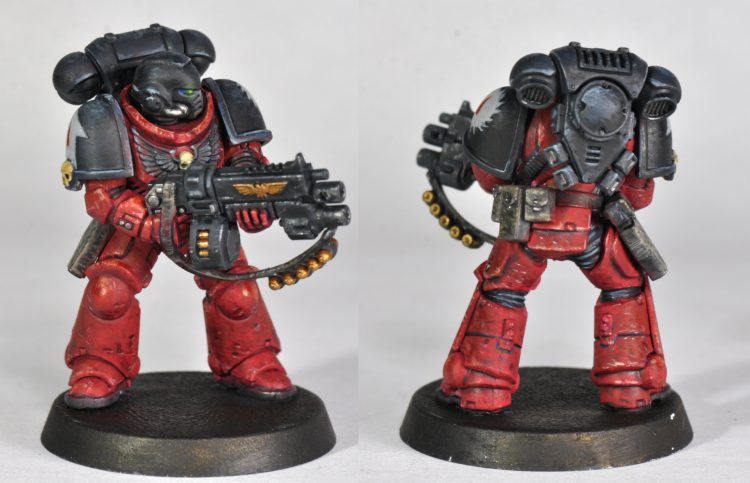
Red Armor Highlights: The armor is highlighted with a mix of Hyek Yellow and Burnt Orange, at least 2:1. Rather that doing continuous smooth edge highlights I did short lines and dots to give it a rougher appearance. The darker splotches were hit with the highlight color on the bottom edges to give them the appearance of a slightly cratered surface.
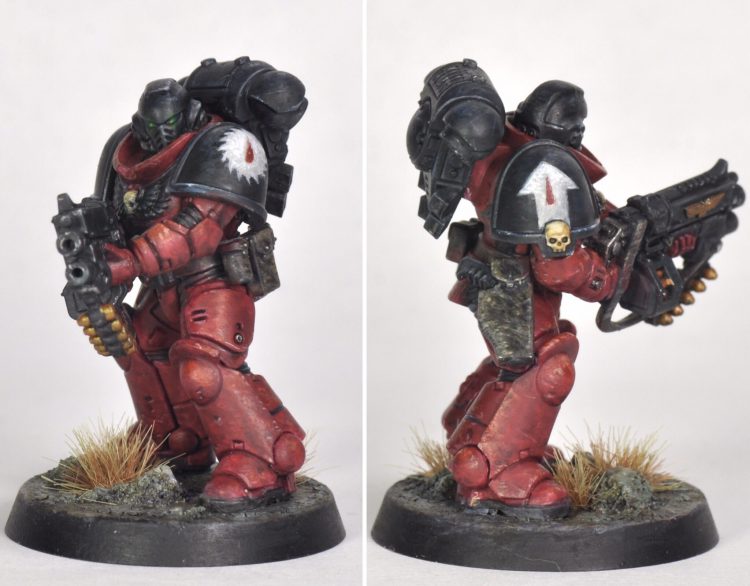
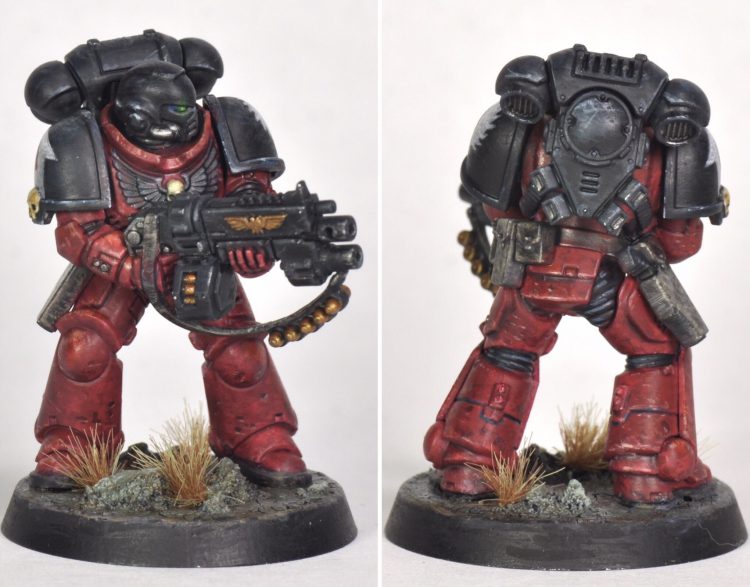
Beanith's Method - Click to Expand
Unlike the sparkly, angst-ridden Pretty Boy Blood Angels whomst revel in the drama hoping to never experience a moment of true happiness lest they succumb to the desire to write some truly dreadful poetry, the Flesh Tearers are actual proper space vampires who are absolute bloodthirsty monsters and are a danger to both friend and foe alike. Clearly this makes them the best Red Marines to paint, play and collect.
As usual I’ll be showing you a quick simple way to smash through the basic troops so you can spend more time playing Satisfactory instead of doing whatever Rob was asking you to do working on the characters and centerpiece models of the army.
Step 1. Undercoat everything with Grey Seer Spray

Step 2. Go to town with Contrast Flesh Tearers Red smooshing this lovely red everywhere and you don’t need to be careful as…
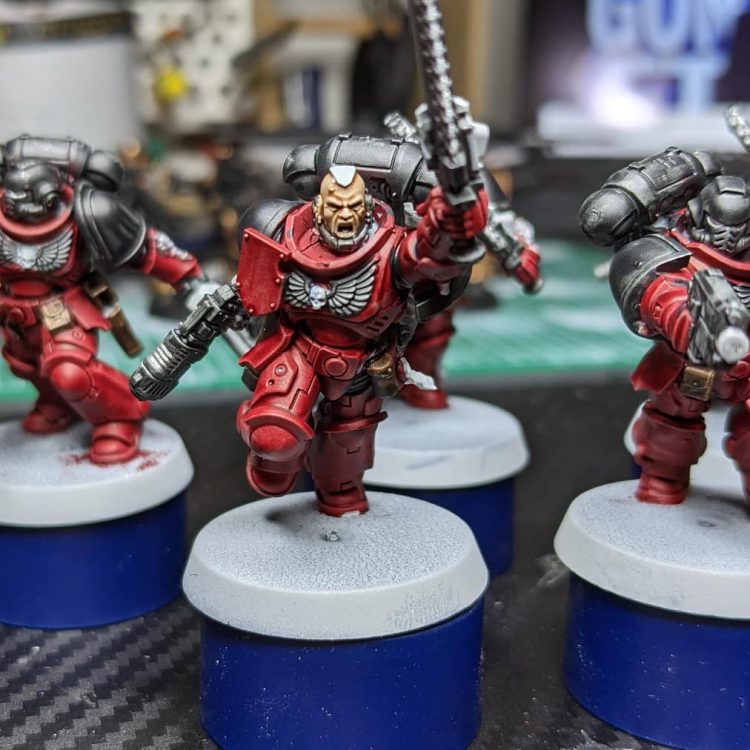
Step 3. Contrast Black Templar will hide all your hobby sins. Shoulders, weapons, backpack and helms are the order of the day here.
Step 4. Details. After this I go back and touch up the smoosh overflow with some Corax White, slap on some Army Painter Plate Metal on the weapon and lenses and smoosh the face with a random Contrast Fleshtone, in this case Darkoath Flesh. If anyone asks about the eyes, claim it’s a tribute to Simon Evans. Chuck on some Contrast Skeleton Horde on the parchment and oddly enough the hair which works for some reason.
Contrast Wyldwood for the pouches, a dab of Contrast Iyanden Yellow on the Purity Seal, Skulls and weapon housing for a spot of colour.
Dab in some Technical Tesseract Glow on the lenses assuming you can find any available and not snapped up by everyone painting up Necrons.
Editor’s note: Aren’t you working on a Necron Crusade army?
Lalala not listening
So I’m kinda done at this point but just in case you run up against That Guy and “YoUr BaSeS aRn’T pAiNtEd” reasoning to try and deny you 10 points, quickly smoosh on some Agrellan Earth and call it Battle Ready done.

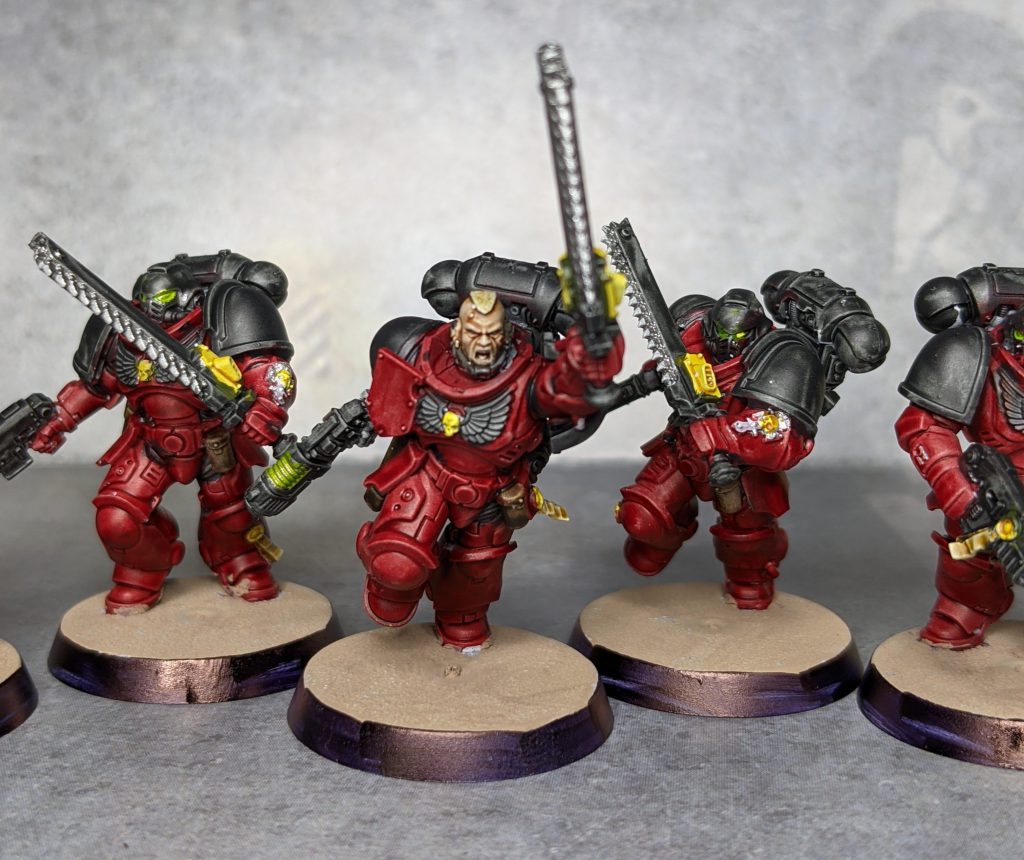
With the recent rules update for Warhammer 40,000 Kill Team, these five lads are destined to become the Proper Space Vampire Kill Team lead by Charles Dance. Which means later on I may go back and apply transfers for squad markings, free hand a circle on the shoulder pads and practice adding teeth to get the chapter icon. Smoosh on a wash on the base and make the panel lines a little darker and accidently arrive at “Parade Ready”. That or finish the monorail to collect the Sulfur on the other side of the map because reasons?
Jack's Method - Click to Expand
I’ve played with some of the same concepts as how I do my Blood Angels and Imperial Fists – building up some shading and highlights in more neutral colors, then tinting the entire model to pull everything together and reach the final color I’m looking for. In this case, I wanted a red a bit darker than I use for my Blood Angels, so during the pre-shade process I refrained from pushing the highlights too bright. I also kept the shoulder pads, helmet, and backpack separate during painting. I’m trying to get nice smooth airbrushed blends, and doing it this way is much easier than trying to mask it.
Red
-

Prime Grey -

Shade Black -

Highlight White -

Thin coats of Crimson -

Pinwash -

Varnish
- Prime a neutral grey, I used Badger Stlynereersz. (no, you cannot make me spell that correctly)
- Add shading with Vallejo Model Air Black. Don’t worry about overdoing it – we’re really going for an overall dark look here.
- Add some off-white highlights. I wanted to be sure not to go too bright, so I didn’t go with pure white. For this model I used Vallejo Model Air Insignia White, but I think a future model might use Vallejo Model Air White Grey or something else about one step down the brightness scale.
- Three coats of Daler Rowney FW Crimson acrylic ink. Each coat brings more vibrance to the red, so do as many as you feel you need. If you want more of the purple tones from the official GW schemes, try using either Process Magenta or Purple Lake as your first layer, or mixing it into the Crimson.
- At this point, jump down to the black instructions and do steps 1-3.
- Gloss varnish the whole thing. While the acrylic inks dry fairly glossy, they’re a pretty fragile coat that you want to add some protection to.
- Apply decals, if you’re using them. I don’t have any floating around, so they’re absent from mine – but the official schema is a white battlefield role marker on the right shoulder, a blood drop over that denoting chapter, an ornate Arabic numeral on the right knee for the squad number, and the chapter icon on the left shoulder.
- Pinwash everything black. You can use your choice of wash here, Nuln Oil Gloss will work fine but I prefer an oil or enamel wash with more surface tension such as Ammo by Mig Black Wash.
- Varnish everything back to matte.
- Carefully edge highlight the red with Scalecolor SC-37 Antares Red. I even highlight into some of the shaded areas to add a bit of definition.
- If you’re painting a character, or just want to take it a bit further, a good next highlight is Scalecolor SC-38 Aldebaran Red.
Black
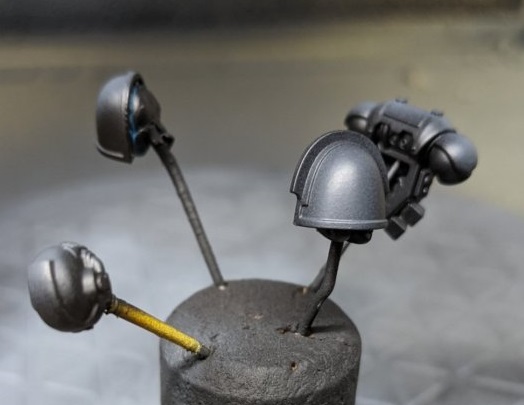
- During assembly we kept the predominantly black areas separate, so we’re going to prime them black.
- Airbrush highlight them with Vallejo Model Air Black Grey.
- Gloss varnish the whole thing. We’re going to work on this at the same time as the reds for a moment, so we’re doing steps 6-9 to apply decals and a pinwash.
- On the rest of the model, paint any black areas (the chest eagle, weapons, and joint ribbing) in Vallejo Model Color Black Grey.
- Wash anything you just painted Black Grey with Nuln Oil.
- Do two steps of edge highlighting – first with Vallejo Model Color Dark Grey, then with Dark Blue Grey.
The Rest
- I’ve really minimized the ornamentation on these guys – that’s a Blood Angel thing, not Flesh Tearers, so I don’t have any fancy golds or purity seals to paint up. (as a side note, this makes painting flesh tearers super quick.
- For the metals, a quick coat of Citadel Iron Hands Steel and then a coat of Nuln Oil Gloss works perfectly.
- Eyes were blocked in with Citadel Grey Seer then Vallejo Model Air All SV. Gol Light Blue
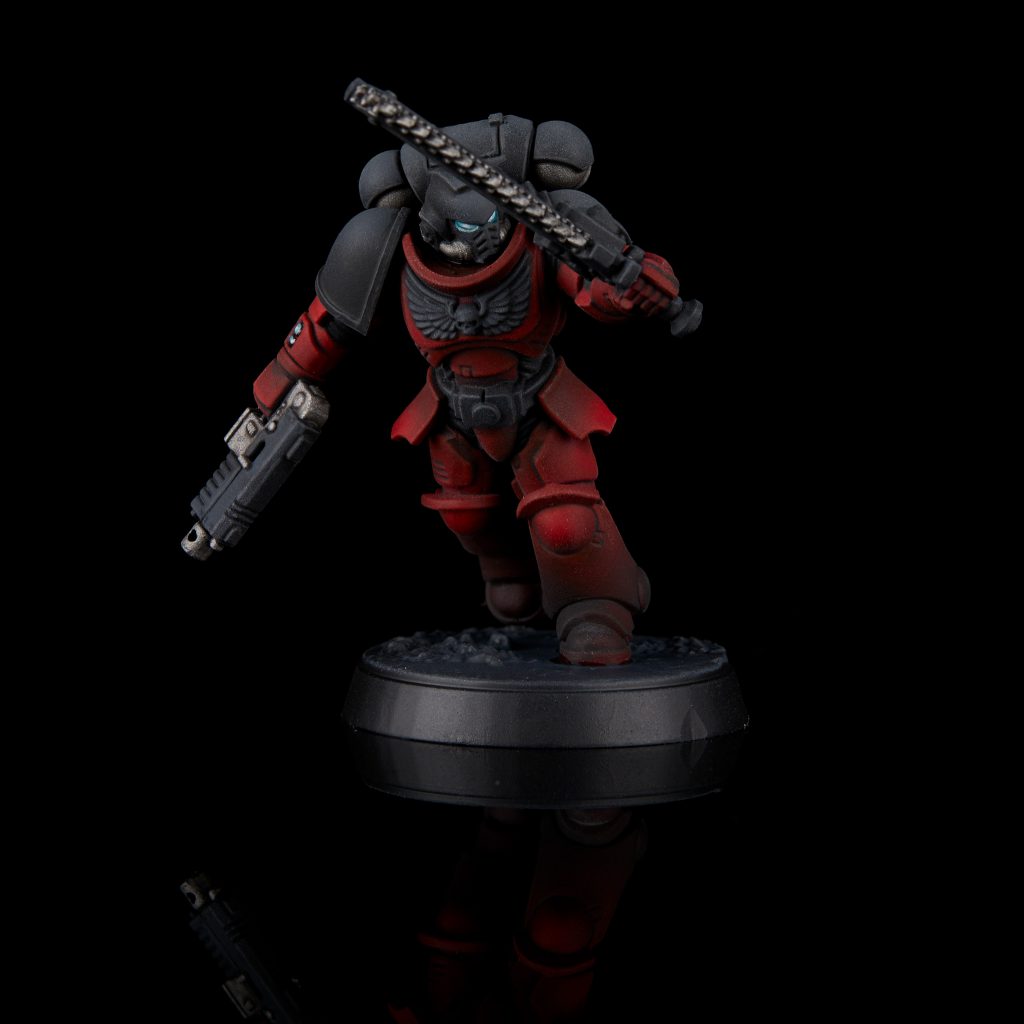
Final Thoughts
That wraps up our look at Flesh Tearers, one of the more savage chapters of the Adeptus Astartes. They’re a fun chapter to paint, and that deep red paint scheme is just so nice on the eyes. Hopefully you found a way to implement it that works for you and if you’re proud of your results, drop a photo in the comments below.
This article is part of a larger series on how to paint Space Marines. To return to that series, click here.




